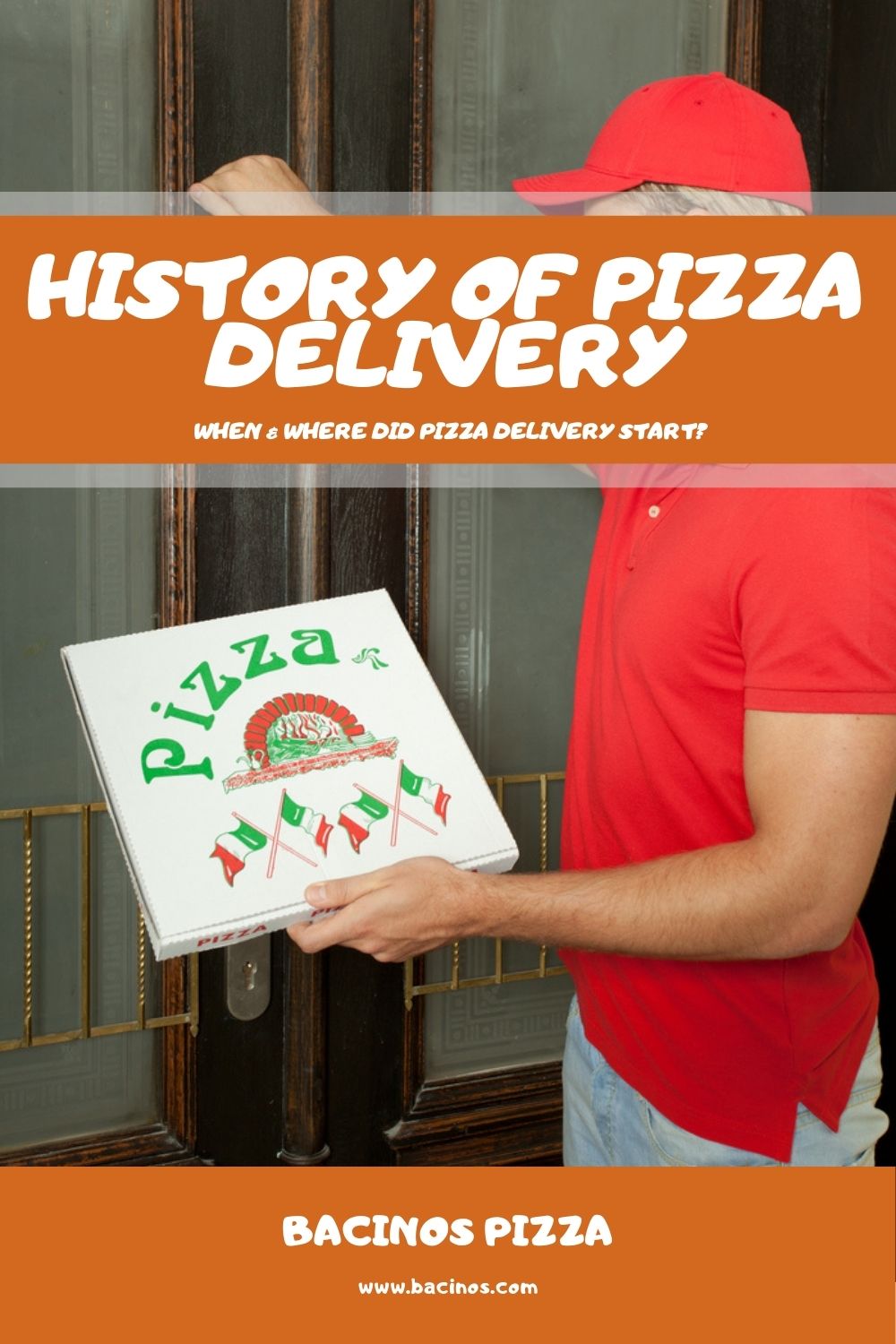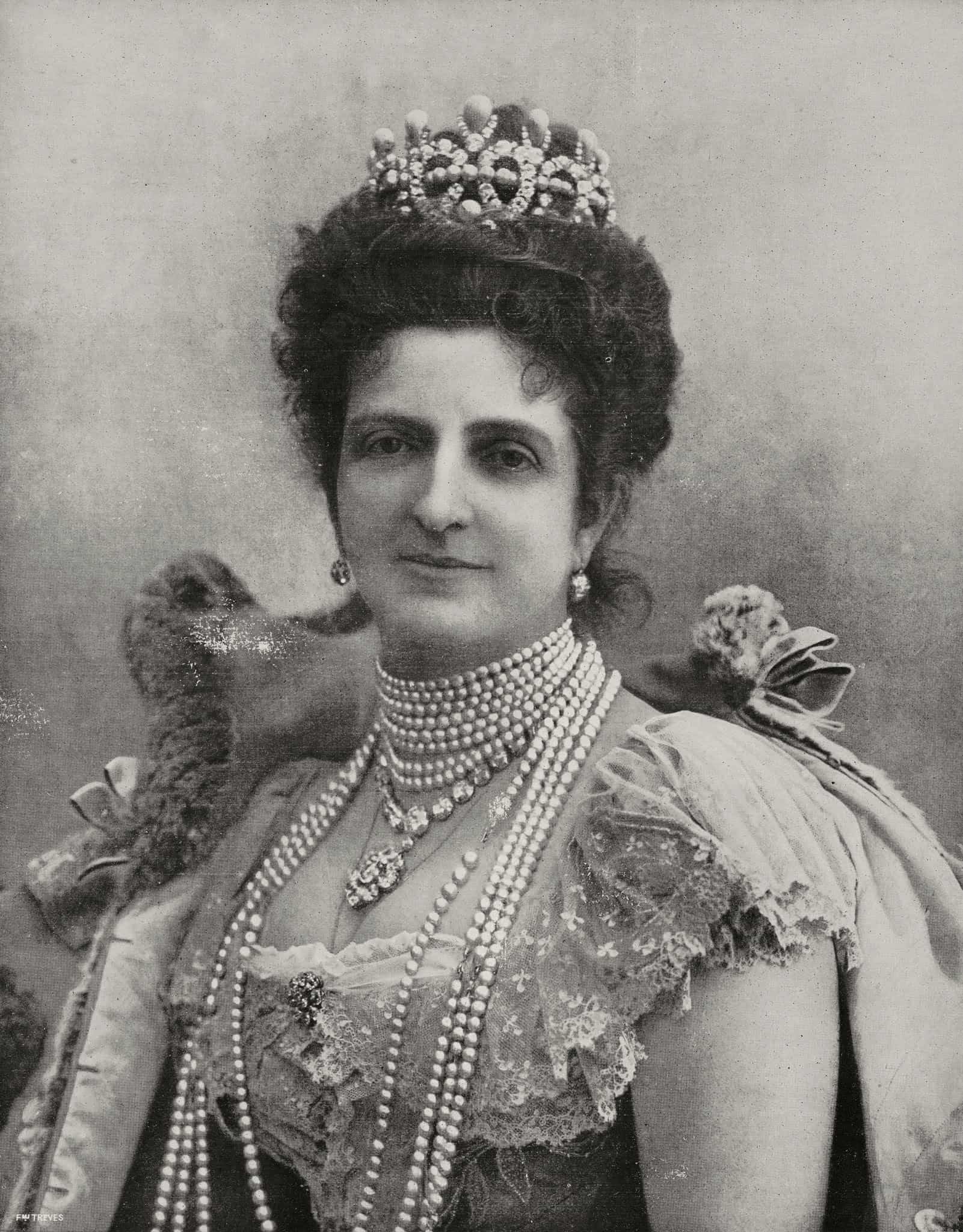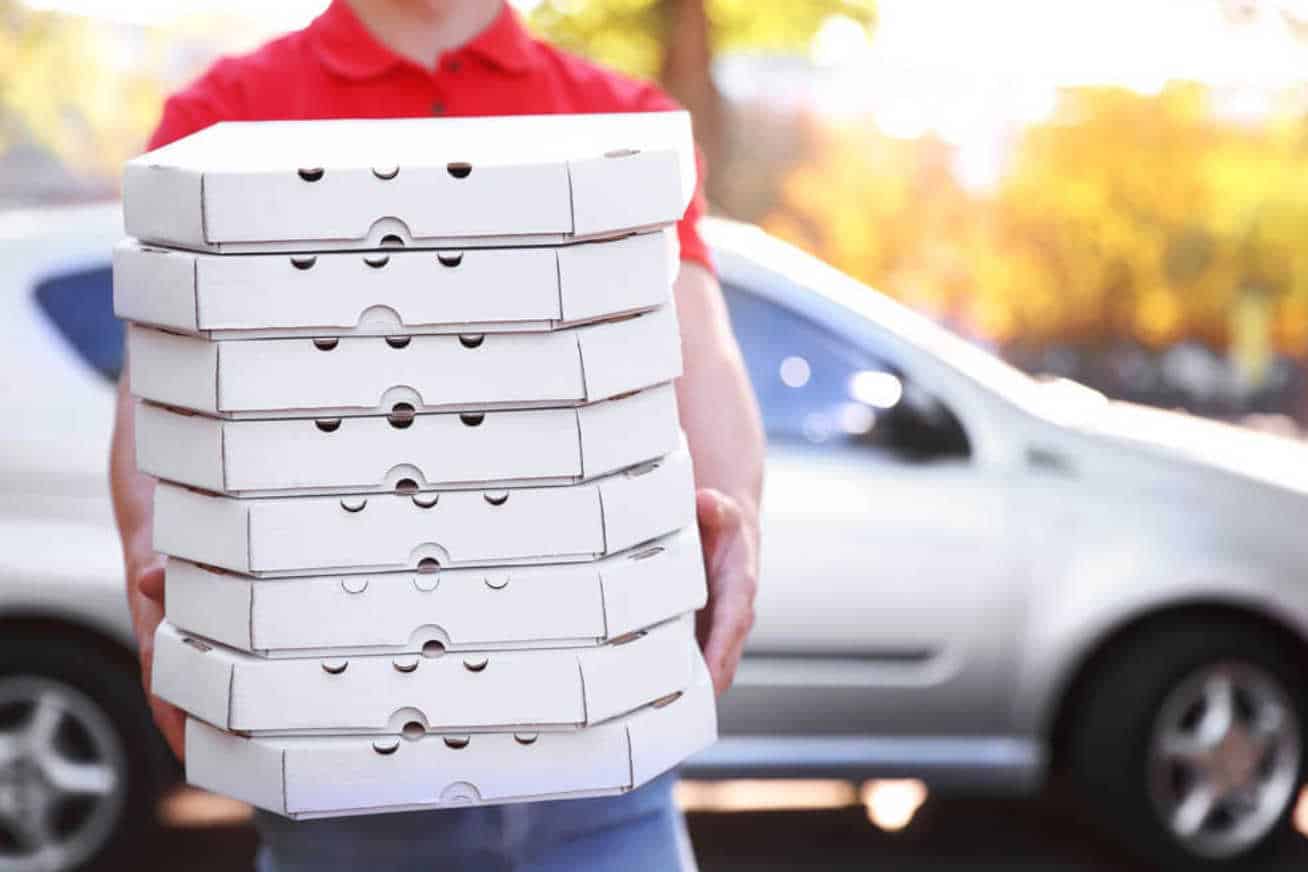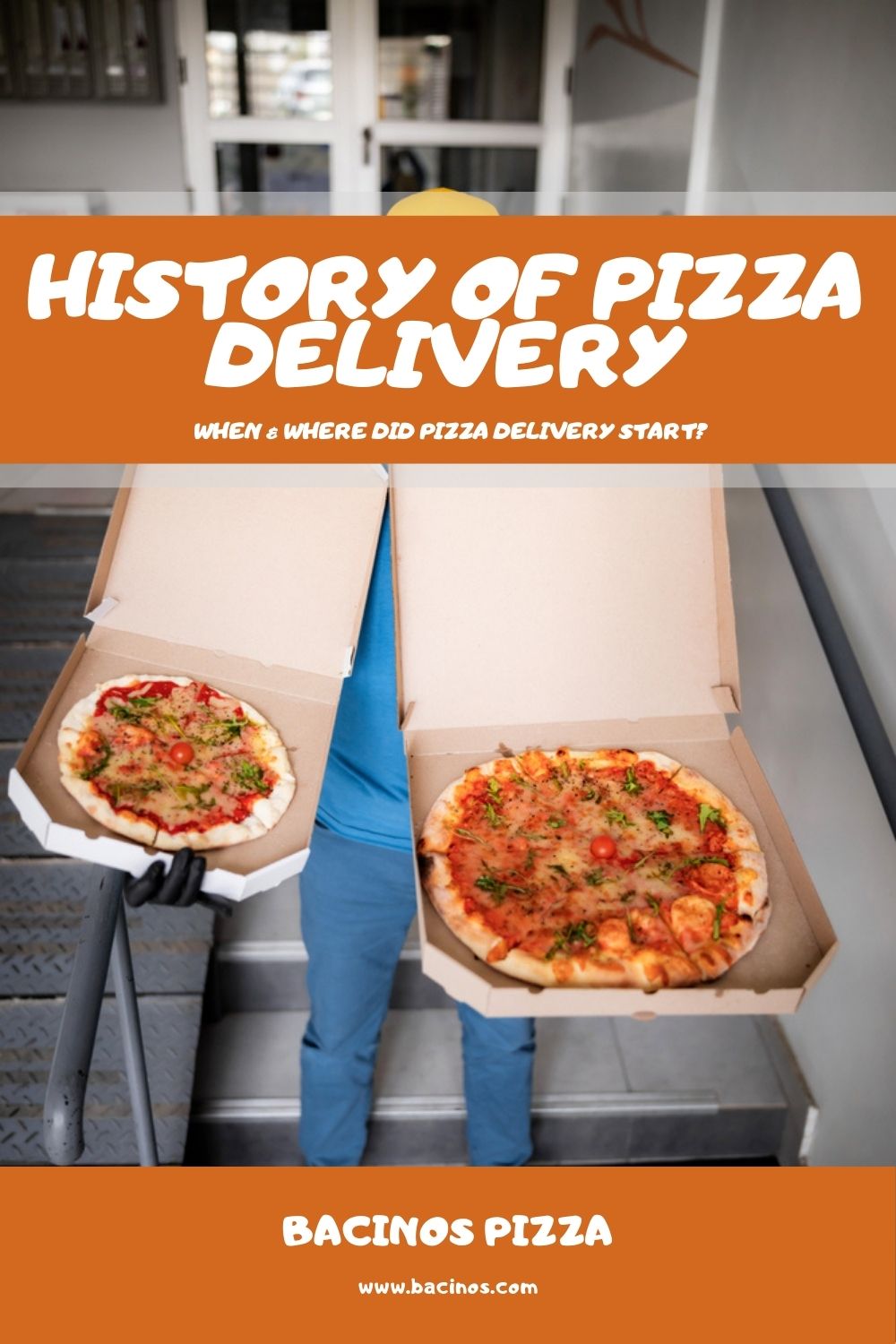We all love the convenience that comes with having a pizza delivered to our doorstep. Whether you’re placing an order by phone or online, you only need to wait for the bell to ring. But do we ever stop to think about how it all started?

It turns out that the practice of pizza delivery has a long history, with its origins tracing back to the late 19th century. Surprising, isn’t it? If you ever thought your dinner was taking too long, appreciate that you weren’t around when the first delivery took place because it started before the invention of cars. Here’s more about the history of pizza delivery.
What is Pizza Delivery?
It’s a service where pizza chains or pizzerias deliver pizzas to customers, sometimes for a fee. An order is made online or by phone to the pizza chain allowing the customer to provide details about the pizza’s size, type, and other products to accompany it.
How Pizza Delivery is Done
Typically, pizzas are delivered in pizza boxes and the deliveries are made by a bicycle, motorized scooter, or automobile. The pizza companies use specialized software to identify the most efficient routes for delivering pizza within a short time.
Many pizza chains aim to deliver pizzas within 20-30 minutes or less after receiving an order. However, the delivery time may vary based on a few factors which include:
- Whether there’s a driver available to deliver the pizza
- The distance between the store and the customer’s house
- Whether the driver has other deliveries to make along with yours
- The traffic and weather conditions
Some pizzerias guarantee a set period. For example, Domino’s Pizza has a strict policy to have every order delivered within 30 minutes or less to ensure customer satisfaction.
The company launched a campaign in the 1980s to offer a free pizza if the 30-minute delivery policy was not met. Pizzerias that don’t offer time guarantees usually provide an estimated delivery time.
Pizza Delivery Fee
Along with pizza delivery comes the question of delivery fees. For many companies, it’s standard to charge a delivery fee. However, for years, many pizzerias followed a free delivery policy. Domino’s Pizza is an excellent example.
In 1999, Pizza Hut decided to experiment by charging 50 cents for each delivery in ten stores. Other stores implemented the idea, and by 2002 a handful of pizza franchises, including Domino’s, charged 50 cents for each delivery.
When Did Pizza Delivery Start?
History has it that Queen Margherita of Savoy reportedly received the first recorded home pizza delivery. Apparently, the Queen and her husband, King Umberto were on a trip and had stopped at Naples.

Queen Margherita was sick of eating the tasty meals served in hotels and wanted a change. It prompted her to request some food at the local eatery, and since it was in Naples, that meant a pizza.
At the time, pizza was a popular street food because it used common ingredients of the time: mozzarella, olive oil, and tomatoes. In fact, nobles regarded it as a meal for local peasants. Chef Raffaele Esposito had been popularizing the affordable street food at his restaurant, and the Queen learned about it through the royal chef.
As such, Raffaele Esposito, the best pizza chef, was called upon to make a pizza for the Queen. Raffaele didn’t disappoint. Instead of making one pizza, Esposito decided to make three of them. The first consisted of tomatoes, mozzarella, and basil to resemble the colors of the Italian flag. The second had garlic and the other had anchovies.
And since the king and the Queen were not expected to visit the pizzeria, Esposito delivered it himself. This was the first-ever recorded pizza delivery and the culmination of the Margherita pizza.
Esposito’s fame spread throughout Europe after the royalty left Naples. You might assume that the general populace had access to pizza delivery as well, but this wasn’t the case. The common class only enjoyed pizza delivery after World War II (1945).
It is believed that the returning soldiers were craving the pizza they had encountered in Europe. Since the soldiers couldn’t visit the nearest pizza shop, they had the pizzas delivered.
Pizzerias in New York City offered to pack the pizzas in individual containers and send them to the soldiers. Years later, pizza chains in Los Angeles offered free deliveries on all orders. This trend marked the beginning of pick-in-store service, popular in many pizzerias today.
Evolution of Pizza Delivery

1. Car-based Pizza Delivery
The 60s marked the beginning of modern pizza delivery. At the time, fast foods were quite common as most Americans had stable incomes. Fast-food eateries, pizza joints, and burger chains began offering delivery services, fundamentally changing the food industry.
Some pizzerias even started offering a 30-minute or less guarantee on pizza deliveries. This policy stipulated that if an order took longer than 30 minutes to deliver, it would be free. However, due to a rising number of accidents caused by hasty delivery drivers, many companies, including Domino’s, abandoned this guarantee in the early 1990s.
2. Impact of the Internet on Pizza Delivery
Pizza delivery has experienced a massive change over the years, and one factor that has propelled its growth is the Internet. In the mid-1990s, a few pizza chains began experimenting with the integration of the internet into their delivery operations, launching an early service known as PizzaNet.
The service allowed customers to go to a pizza chain’s website and order a pizza. Many customers were initially skeptical about this new method, but fast-forward 20 years, and online pizza delivery has become a staple in the industry.
The proliferation of mobile applications around 2009 propelled online pizza delivery further, and in the following years, well-known pizza chains and small pizzerias developed apps that allowed customers to:
- Order their favorite pizzas
- Track orders
- View the chain’s menu
3. App-based Pizza Delivery
After setting up online pizza delivery, the next step was setting up delivery systems that ensured fast delivery. Of course, the chef can’t deliver, as in the case of the first-ever pizza delivery.
Many pizza chains resorted to the use of cars, but ongoing technological development led to the innovation of exclusive food delivery services. The service doesn’t eliminate pizzeria’s exclusive apps but broadens their scope.
Some online food delivery services partner with Google to enable customers to initiate orders using Google Maps. Also, consumers can use mobile applications to make orders in advance, skipping long queues. Examples of such pizza delivery services include:
- UberEats
An additional invention by Uber, this online food ordering and delivery platform enable customers to place orders and track them. What’s more, the delivery service learns the customer’s preference, makes customized recommendations, and provides half-hour delivery options.
- Slice
If you’re not a fan of the big pizza chains, Slice has got you covered. The app allows you to create custom pies to order exactly what you want. You can also re-order your favorites with a few taps.
- Grubhub
While it’s not an exclusive pizza delivery app, you can use it to find the nearest pizza restaurant. Type the word ‘pizza’ into the search bar, and a list of all the pizza joints near you will appear. The app also helps you find delivery restaurants, takeaway spots, or both. Also, you can store payment information, so you don’t need to fumble with your card every time you’re ordering a pizza.
Other notable innovations in pizza delivery involve the use of delivery trucks. A robot sends the prepared pizza through a conveyor oven while the truck moves toward your home or your specified delivery location. The premise is to reduce delivery time and deliver the pizza while it’s still hot. Pizza Hut is one company that has embraced this idea to expand its delivery reach.
The company in partnership with Toyota has developed a mobile pizza factory that can deliver oven-hot pizza. The factory features a unique truck bed that has been converted into a virtual pizza factory on wheels.
It contains a portable conveyor oven, a pair of robotic arms, and a refrigerator. Once you order a pizza from Pizza Hut, one robotic arm opens the refrigerator and removes the desired pizza, places it on the oven conveyor, and returns to close the door. The second arm removes the finished pie, places it on a cutting board, divides it into slices, boxes it up, and delivers it to the customer.
4. Driverless Pizza Delivery
Pizza delivery continues to impress countless people as large pizzerias constantly reinvent the service to enhance convenience. One such invention is the driverless pizza delivery which Domino’s recently piloted. Domino’s in partnership with Nuro, a self-driving delivery startup company, launched a pilot for driverless pizza delivery.
The idea is to enable customers to place a prepaid order on Domino’s website for delivery. If the customer places the order within specific times and days, they can choose to have Nuro’s robot drop off the pizza.
On arrival, the customer types a unique PIN on the robot’s touch screen to activate the doors to open for pizza retrieval (delivery). Domino’s has invested in technology to make pizza delivery fast and easier, and driverless pizza delivery is one recent focus. Of course, the company is years away from replacing fleet drivers, but the new technology is worth exploring.
Summary
Pizza delivery has come a long way. And with companies committed to reinventing their delivery tactics, we’re bound to see more cutting-edge pizza delivery services to reduce delivery time and enhance customer satisfaction.


Barbara is an enthusiastic food-exploring person that goes through different culinary experiences. She got inspired by creating a pizza blog post after she tasted one of the best-selling pizzas in Toledo.
Why do papa John’s pay only 425 on the road